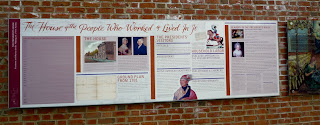
While I was at home over the holidays, I had a chance to stop by the newly opened, and highly controversial, President’s House in Independence Mall. Actually, while this new site is referred to colloquially around Philadelphia (and within the larger Heritage community) as the President’s House, it’s formal title is: The President’s House: Freedom and Slavery in the Making of a New Nation. The controversy stems from both the subject, as well as the design.
The President’s House (PH:FSMNN?), is an eight year, $10.5 million project, undertaken by the City of Philadelphia, with considerable input from the Avenging the Ancestors Coalition. It is positioned within the larger Independence Mall, or Independence National Historical Park, which includes Independence Hall and the Liberty Bell.
It is exactly this placement that sparked controversy and prompted the project. During the construction of the new Liberty Bell Center, the footprint of an earlier building was discovered, which was later discovered to be an outbuilding, perhaps the slave quarters, associated with the President’s House. Following the publication of Historian Edward Lawler’s 2002 article “The President’s House in Philadelphia: The Rediscovery of a Lost Landmark” in the Pennsylvania Magazine of History and Biography a campaign was led by the Avenging the Ancestors Coalition to have a commemorative site built to honor the slaves that were owned my the Nation’s first President.
There are major issues with even calling the house “The President’s House”. The house was built in 1767 for another owner and wasn’t even inhabited by Washington until 1790. By then, quite a few people, including Benedict Arnold and Robert Morris, had lived in the house. This is dealt with a bit in the “History of the House and the People who Worked and Lived in it” section, but each of the other inhabitants get about a sentence each.
Officially, this is the first slavery memorial on federal land (to clarify, the African American Museum in Philadelphia, which is one block west of the President’s House, is not a Federal site) so this is a VERY big deal - it’s the 21st century, why has it taken this long? However, if the aim of the site was to discuss slavery in the eighteenth century or even to illustrate the hypocrisy of the founding father’s stance on freedom, then I would have liked to see innovative interpretation. And the exhibit designers seem to have confused innovative interpretation with shiny new technology.

There are five television screens with actors portraying the slaves owned by Washington placed around the site. However, they are all within about seven or eight feet of each other, are running simultaneously and it’s an open-air site on one of Philadelphia’s busiest streets – how are visitors expected to hear what the actors are saying? I was there at about 8:30am, two days before Christmas, so there was decreased road noise, and I had difficulty hearing.
Even with the traditional text panels there are issues. The slave trade and slave-based economy in early America text panels are illustrated with a map that I swear is in every grade school history textbook.  To make this more interesting, more personal, more real, I would have liked to see pictures or maps that illustrated the lives of the slaves that lived at the house - since they have the records of each of these slaves, I’d like to see more on each of them; fewer generalities, more specifics.
To make this more interesting, more personal, more real, I would have liked to see pictures or maps that illustrated the lives of the slaves that lived at the house - since they have the records of each of these slaves, I’d like to see more on each of them; fewer generalities, more specifics. 
 To make this more interesting, more personal, more real, I would have liked to see pictures or maps that illustrated the lives of the slaves that lived at the house - since they have the records of each of these slaves, I’d like to see more on each of them; fewer generalities, more specifics.
To make this more interesting, more personal, more real, I would have liked to see pictures or maps that illustrated the lives of the slaves that lived at the house - since they have the records of each of these slaves, I’d like to see more on each of them; fewer generalities, more specifics. 
The debate over how to interpret slaves and slavery within this context brings to mind the National Trust and their interpretation of “downstairs” history in their country house properties and its associated negative reviews. Some have felt that the NT has put a considerable amount of effort exploring the world of the servants in many of their properties only to be incredibly patronizing in their efforts. On the flip side, others have felt that by putting the servants first, the reason for the servants has been lost – that is, the attention has been too far removed from the family that owned the property.
Both of these debates make me wonder about how the decisions are made as to what aspects of sites/history should be interpreted. In a perfect world, the entire history would be interpreted in some way, but clearly it would be hard to cover vast amounts of history well.
Okay, rant over.
If you’re interested, you can read more about the debate here:
